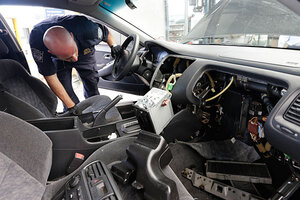Along key stretch of US-Mexico border, more kids running drugs
The Tucson sector of the US-Mexico border has seen an alarming rise in the number of juveniles facing drug-smuggling charges. Teens are also carrying harder drugs into the US.

A Customs and Border Protection officer looks at the dismembered dashboard of a Honda Accord after finding more than 14 pounds of methamphetamine hidden behind the radio at the San Ysidro port of entry in San Diego last month. Border officials say teens are also increasingly being used as mules for hard drugs like methamphetamines.
Gregory Bull/AP/File
TUCSON, ARIZ.
On a balmy Monday afternoon, authorities at a highway checkpoint a few miles north of the US-Mexico border pull over a commercial shuttle for inspection. A teenage girl sitting inside appears rattled and, as it turns out, with good reason. Several bundles of heroin are weighing down her bag.
By the time border patrol agents finish checking all passengers, the teen and three other female minors are in custody. All had heroin packets tucked in their waistbands.
This incident from April was the latest in a string of recent cases in Arizona where juveniles have been arrested trying to smuggle drugs into the United States. While luring teens to act as drug mules for a few hundred bucks is not a new practice, the Tucson sector of the US-Mexico border – the nation's busiest – has seen an alarming jump in the past two years.
In 2012, 244 minors faced drug-smuggling charges in the Tucson sector, compared with 122 in 2011. By the end of this May, the number was already 154.
Moreover, all along the border, officials say minors are increasingly being used to traffic hard drugs such as methamphetamine, heroin, and cocaine, not just marijuana, as was mostly the case in the past.
"That's kind of new and alarming," says Lauren Mack, a spokeswoman in San Diego for Immigration and Customs Enforcement (ICE).
Drug trafficking organizations lure minors to smuggle drugs with promises of money and assurances that there will be few consequences if they are caught, says Manuel Padilla, chief of the border patrol's Tucson sector.
"The reason they do that is because it's very difficult to prosecute children or juveniles through the federal system," he adds.
At the ports of entry and interior checkpoints, border authorities are encountering teens who strap drugs to their abdomen, inner thighs, and other body parts.
Although traffickers long have used the drug-smuggling method, the uptick in minors as body carriers is a fairly recent phenomenon, says Ms. Mack of ICE.
Investigators have seen children as young as 12 act as drug mules, although most usually are between the ages of 15 and 18, says Jose Garcia, deputy special agent for ICE Homeland Security Investigations in the San Diego area.
Youngsters are known to be recruited at arcades and other teen hangouts, by word-of-mouth, and through social media, Agent Garcia says.
The appeal of easy money is strong for vulnerable youths, he adds. "We're in a very materialistic society ... and these organizations capitalize on the sense kids have that nothing's ever going to happen to them."
On average, young smugglers make $200 to $300 each time they smuggle drugs, the agent adds. "It's not a lot, but for a teen, it can be."
Traffickers often tell young people that if they're arrested, they will get a slap on the wrist and then be released to their parents.
"All of these things are lies," Garcia says.
In California, for example, young suspects can end up with two felonies on their records, which for many can mean a year in juvenile detention, Garcia adds.
Depending on the seriousness of the offense, teens in some cases are being prosecuted as adults.
"Through this new system, now the main charge for kids carrying hard narcotics is possession with intent to distribute," Chief Padilla of the border patrol says.
In Arizona, the four teenage girls carrying heroin underneath their clothing found out the hard way. They were 15 to 17 years old, two from the US and two from Mexico. Combined, the nearly 8 pounds they carried had an estimated street value of $90,000.
The border patrol turned the teens over to the Santa Cruz County Sheriff's Office, which increasingly works with state and federal authorities to prosecute young drug-smuggling suspects with felony charges rather than juvenile delinquency. Each of the teens was charged with two felonies related to unlawful possession and transportation of drugs.
After pleading guilty to a lesser felony offense, the younger girls were sentenced to 90 days in juvenile detention and unsupervised probation until they turn 18, says George Silva, the Santa Cruz County Attorney in Nogales, Ariz. The older girls are being tried as adults and are waiting for an initial court appearance, Mr. Silva adds.
Borderwide statistics on juvenile trafficking are not available, but data from California suggest the trend is not as apparent there. In 2011, 77 minors charged with drug smuggling were prosecuted in San Diego County, up from 65 in 2010. But the number dropped to 72 in 2012, and so far this year, prosecutions total 36, says Michele Linley, chief of the juvenile division for the District Attorney's Office in San Diego.
For teens, the experience of being arrested and prosecuted for smuggling drugs is "awful, but it could be a turning point for them in their life," she says.
Authorities also are working to keep youngsters from getting involved in drug smuggling in the first place through programs in local communities. In 2009, authorities in the Del Rio sector in Texas launched Operation Detour in schools, which educates youngsters about risks and consequences, and the program has been expanded to Arizona and other areas.

